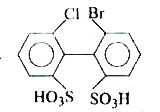Which of the following will not show optical isomerism ?
Cl−CH=C=CH−Cl
Br−CH=C=CH−Br


The correct Answer is:C
To determine which of the given compounds does not show optical isomerism, we need to analyze each compound for the presence of a plane of symmetry. Optical isomerism occurs when a molecule can exist in two non-superimposable mirror images, which typically happens when there is no plane of symmetry in the molecule.
1. Understand Optical Isomerism:
- Optical isomerism arises in compounds that lack a plane of symmetry. If a compound has a plane of symmetry, it cannot have optical isomers.
2. Analyze Each Compound:
- Compound A:
- Structure: C1=C2 (with Cl and H on C1 and C2).
- Analysis: If the two terminal carbons have different groups, this compound will show optical isomerism because it lacks a plane of symmetry.
- Compound B:
- Structure: C1=C2 (with Br and H on C1 and C2).
- Analysis: Similar to Compound A, if the two terminal carbons have different groups, this compound will also show optical isomerism due to the absence of a plane of symmetry.
- Compound C:
- Structure: Fischer projection with groups COOH, H, OH.
- Analysis: This compound has a plane of symmetry that divides it into two equal halves, making it optically inactive. Therefore, it does not show optical isomerism.
- Compound D:
- Structure: Newman projection converted to Fischer projection.
- Analysis: After conversion, if there are no identical groups on the same carbon and no plane of symmetry, this compound will show optical isomerism.
3. Conclusion:
- The only compound that does not show optical isomerism is Compound C due to the presence of a plane of symmetry.
Final Answer:
The compound that will not show optical isomerism is Compound C.
- Optical isomerism arises in compounds that lack a plane of symmetry. If a compound has a plane of symmetry, it cannot have optical isomers.
- Compound A:
- Structure: C1=C2 (with Cl and H on C1 and C2).
- Analysis: If the two terminal carbons have different groups, this compound will show optical isomerism because it lacks a plane of symmetry.
- Compound B:
- Structure: C1=C2 (with Br and H on C1 and C2).
- Analysis: Similar to Compound A, if the two terminal carbons have different groups, this compound will also show optical isomerism due to the absence of a plane of symmetry.
- Structure: Fischer projection with groups COOH, H, OH.
- Analysis: This compound has a plane of symmetry that divides it into two equal halves, making it optically inactive. Therefore, it does not show optical isomerism.
- Structure: Newman projection converted to Fischer projection.
- Analysis: After conversion, if there are no identical groups on the same carbon and no plane of symmetry, this compound will show optical isomerism.
- The only compound that does not show optical isomerism is Compound C due to the presence of a plane of symmetry.
The compound that will not show optical isomerism is Compound C.
Similar Questions
Knowledge Check
- Question 1 - Select One or More
Which of the following will show optical isomerism?
A B
B C
C D
D
- Question 2 - Select One
Which of the following will not show geometrical isomerism ?
ACH3−C∣CH3=CH−CH2−CH3BCH3−CH∣CH3−CH=CH−CH2−CH3CCH3−CH=CH−CH3DCH3−CH2=CH−CH2−CH3
Which of the following will show optical isomerism?
View SolutionWhich of the following does not show optical isomerism?
View SolutionWhich of the following will not show geometrical isomerism ?
View SolutionWhich of the following will not show geometrical isomerism?
View SolutionWhich of the following will not show geometrical isomerism?
View SolutionWhich of the following will show geometrical isomerism ?
View Solution
